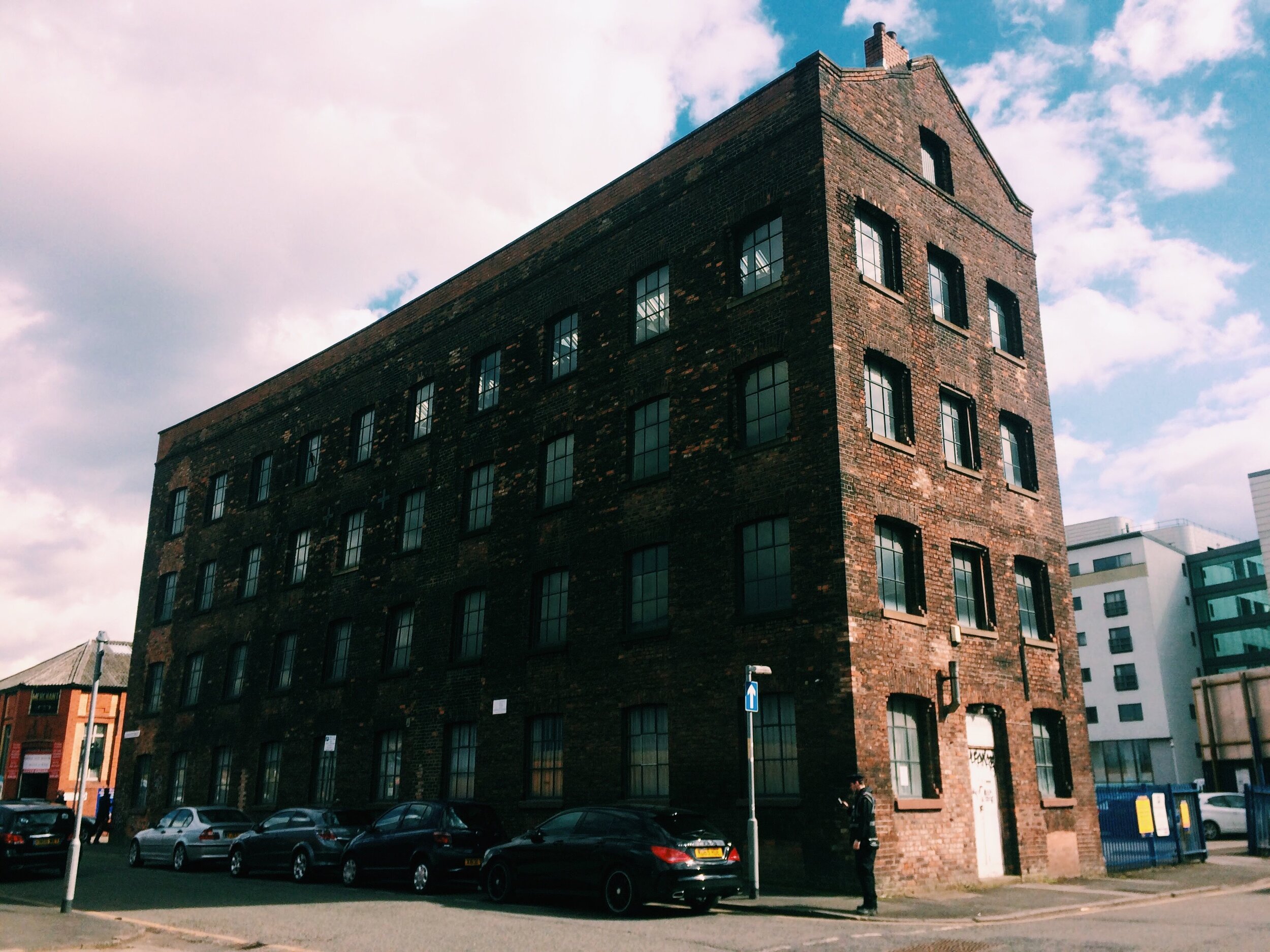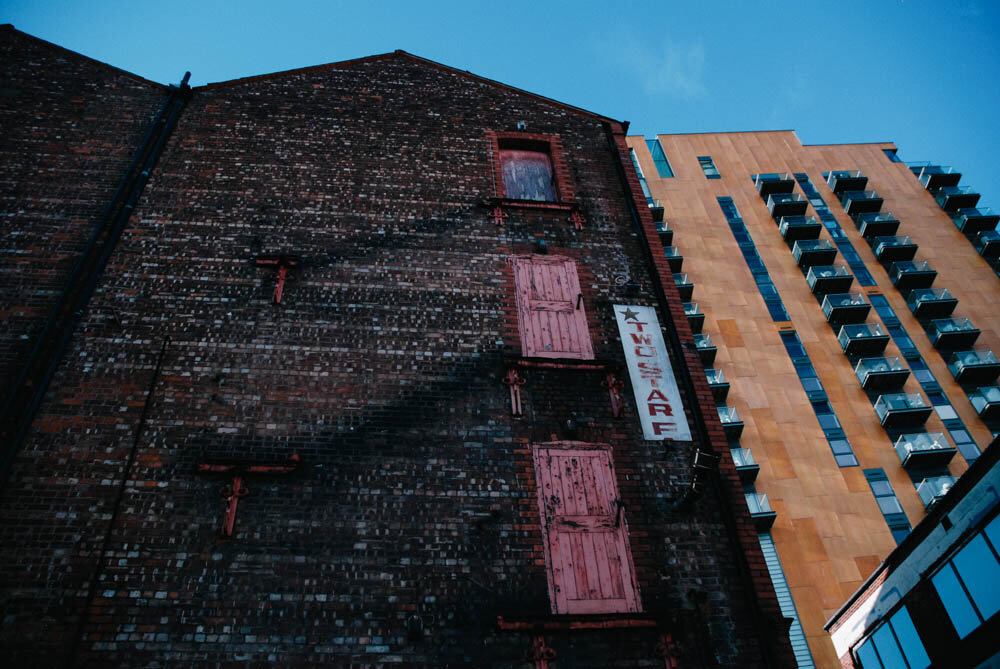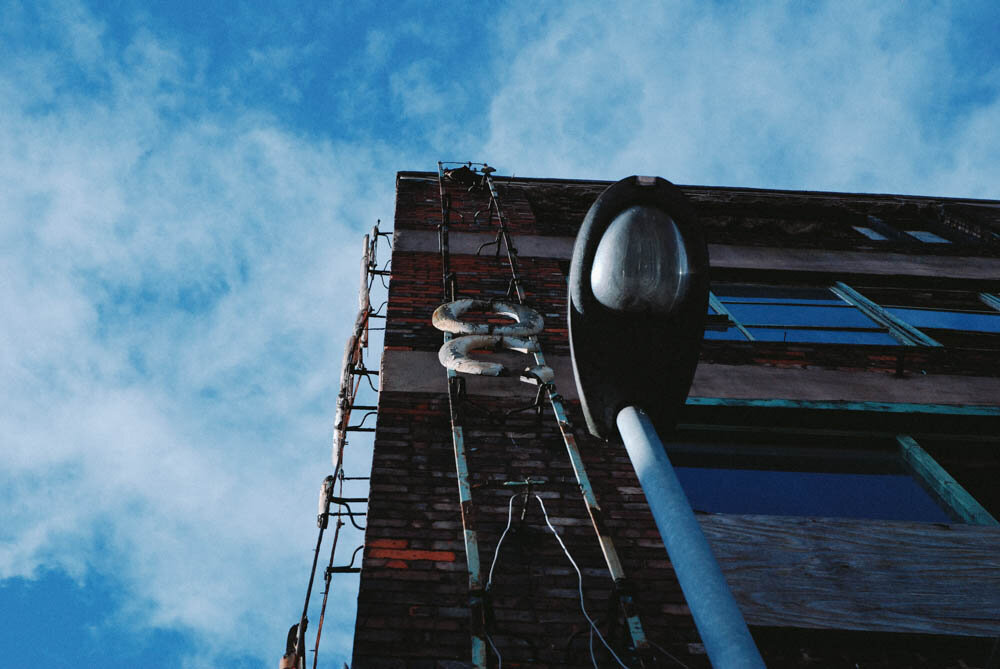A walking essay following nature into spaces of decay
WORDS & IMAGES Hayley Flynn
READING TIME: 9 minutes
Part I: Spear Street, and the bonking beetles.
Spear Street is in flux: either side of the street, empty lots, are now in the rapid process of redevelopment and the foundations for 102 flats are being prepared. This may well spell the end for a strange little community that has taken over the street in recent years, but only time will tell...
In 2013 the west side of Spear Street was occupied by the Dobbins building, a former drapers, ‘a paradise for window gazers’, and home to an unlikely tea room that was a popular hideout and dancing spot for stars such as George Formby and Tom Mix during the 1930s. The art deco style warehouse, resembling a cinema, originally had a huge glass roof but was damaged during the Blitz. In 2013 the warehouse, which had been a vintage clothing shop in its last days, burned down and once demolished it was was replaced by a surface level car park. Residents, dismayed by the car park culture of the city, saw an opportunity to peacefully protest and would pay for parking bays, turn up with astroturf rolled up under an arm like a beach towel, a pot plant under the other, and create car-sized plots of temporary green space where they would sunbathe and picnic. Soon after the protests hoardings were put up around the car park and it was locked up for private use by the landowner, which was often used as a car park for one lone car, occasionally it was left unlocked and a local man would leave his dog roaming, gate pulled to, whilst he went for chips at Kingfishers, and corners of the plot quickly became filled by fly-tippers, all the while buddleia strained at the seams around the site.
What the loss of Dobbins did was to provide the area with two newly-exposed gable end walls, previously obscured by the warehouse. They became the canvas to two of the city’s most famous street art murals - The 22 Bees by Qubek, a tribute to the victims of the Manchester Arena attack, and a striking piece by Dale Grimshaw about the effect of globalisation on indigenous populations. As I write, these are their last days. The foundations to the new apartments have been dug, exposed, and piles of bricks, once buried beneath the tarmac, are heaped up in front of the worker bees obscuring all but the wing tips.
The hoardings here have become a popular graffiti gallery and the works change every couple of weeks, a practice space for a burgeoning community of street artists and graffiti writers, the latter continuing the legacy of Tony Kelzo - one of the pioneers of the hip hop derived graffiti made popular on the subways of New York. Kelzo created one of the largest graffiti galleries in Europe on the walls of Hulme in the 1980s, behind this canvas squatters took a sledgehammer to the internal walls and made a music venue out of the abandoned flats - another space where things were allowed to grow in the ruins: colours and noise sprung from the Hulme Crescents’ squats and the winds of change crested the city chimneys and blew off the soot.
The buddleia on Spear Street is unusually tame and grows neither high nor dense - you’re more likely to spot rats down here than you are flowers, and yet in summer its overrun with Common Red Soldier beetles. Also known as the ‘Hogweed Bonking Beetle’, it’s puzzling that they live on Spear Street: the buddleia is too sparse to attract them in such droves, besides it's not their flower of choice and I’m yet to see one so much as land on the droopy purple bush. They seem to prefer the hoardings and the kerb: they’re found in the gutters, turmeric-coloured stains squashed onto the road, or tangled up in your hair. So far no one has been able to tell me what’s drawn them to the street, and kept them here, but what puzzles me the most is that once you hit the intersecting roads at either end of this particular leg of Spear Street, they stop, never to be seen anywhere but this penultimate stretch of the road before it hits Great Ancoats Street.
Part II: Redhill Street, and its peepholes
Great Ancoats Street
On the site of the former Central Retail Park on Great Ancoats Street bulbous indigo tomatoes, a waning fig tree, and a small crop of strawberries grow in a corner of the site - much like the Dobbins car park, these were planted here during a recent protest to demonstrate the need for green space and not another car park. The proposed car park was announced just a few days after the local council declared a climate crisis, and soon after that they announced the removal of some stretches of cycle lanes in the redevelopment of Great Ancoats Street - an already tough to penetrate road that acts as a sort of moat around the East side of the city. It’s transpired since then that the current air pollution in this part of Manchester is at an illegal level; Manchester has some of the worst rates of childhood asthma and the proposed car park? Well, it bounds the site of the only city-centre school. I look at the tomatoes and the figs struggling against the tides of nitrogen dioxide in the same panicked way I look at a hatchling fallen from her nest. A look of hopelessness, paralysis, and a need to act.
The site is a distress to me and I’m stood alone, sort of bewildered by it, and aware of how exposed I am in all the ways I can be. Had it been 100 years earlier the fig might fight back: in Sheffield along the banks of the Don a forest of fig trees thrives thanks to artificially heated stretches of the river - a by-product of the industrial revolution and the steelworks on the shore. Or perhaps they might flourish even now; we only have to look to the buddleia as evidence of our changing climate, even until the 1980s, maybe later, it rarely grew in the North of England. For fear of that rapidly changing world, I suppose I will the fig to die.
The buddleia hasn’t really ventured this way yet, and I get back on track in pursuit of it by crossing the Rochdale Canal - kicking, as I find myself doing several times a week in this city, hypodermic needles into the verge as I go.
Over the bridge into Ancoats, on Redhill Street, I stop at the foot of the stairs. That wasteland of moments ago, over my shoulder, is hidden in plain sight now by the deafening geometry of the urban village. Cobbles and bricks creating rectangles as far as you can see, and the uniform windows of the former mills, neat boxes like sudoku charts, run parallel with the stretch of the canal until new, limp grey developments break the grid. In Royal Mill, the sheer face of which confronts me now, the lift shaft was installed where the toilets once stood. On the wall in the female bathroom wartime graffiti read: ‘I wish Johnny would follow me home in a blackout’.
Focussing back onto the bridge now, I turn to face it and to my left is a brass peephole set into the brick. The peephole formed part of a public art trail called the Ancoats Peeps that hoped to show spaces that have been ‘walled up for some time, but [are] not entirely still’. The artist Dan Dubowitz said of the peephole locations that these were all ‘places of the ordinary everyday activities of a working industrial city and suburb; places to eat, move, pee, produce, and they were unexpectedly highly charged and somehow extraordinary by consequence of what had become of them’.
This particular peep shows the back wall of a former urinal, a sort of dull history but by tuning into it it makes you hyper-aware of the stories all those other brick walls might tell. With your eye to the peep notice the ferns that grow in the Victorian urinal despite the limited light, slivers of which have found their way into the cave-like space, and the moist brickwork of its canalside location give the plants momentum. I’ve heard ferns described as an understory, something unremarkable that bides its time amongst the mushrooms whilst overshadowed by a huge canopy of magnificent trees. It plays very much that role here too, lurking out of sight whilst bricks multiply upwards all around it.
Across from the peep, a goldcrest suffering from window strike seems to bob on the edge of the pavement, like a buoy, and she is silent and still as I watch a passerby lift her into the undergrowth of the bushes where earlier I sent dirty needles scattering.
A series of peeps, some themselves taken over by nature; crusted with something lichen-like, lead me out of Ancoats towards New Cross.
Rochdale Canal in summer
Redhill Street peep
Lichen covering a peephole
Part III: New Cross and its leaning tower.
Buddleia is an opportunist, it can sprout quickly and almost anywhere, it can be seen billowing from blocked-up chimneys and, more often, gripping the brickwork of city-centre buildings like an apocalyptic spider. Adrian Chiles wrote that the plant was: ‘a sure signifier of neglect.’ Now in New Cross, an area that’s in the midst of huge redevelopment, many of these areas of neglect are in the buddleia’s embrace, or stranglehold, depending on how you look at it.
On Cable Street, in the grounds of a former garage (presumably contaminated land and therefore caught in a sort of limbo), there’s a forecourt area taken over in August by great bursts of purple. Now, in the run-up to winter, its been tended and tamed, a seemingly fruitless exercise for a site with no immediate future. In summer this was quite a seductive plot of land - full of bees and colour, and overlooking the Mackie Mayor food hall: had the moat road of Great Ancoats and Swan Street not cut an ugly divide between the two it wasn’t such a leap of faith to imagine the forecourt as a sweet little patio for the food hall. Cities grow and its ring roads eventually become sucked into the core, what was once a boundary eventually becomes a poorly-placed insular road, the unmoving hem-line of the city.
In some cities, these major roads are driven underground to reduce their impact on people, or decent links and pedestrian bridges are thrown up across them at the very least. These pedestrian connections actually help the growth of cities, look at Ancoats and that great grey divide between it and the Northern Quarter - would a tourist ever think to cross that road? In the eyes of those without a destination in mind, the city ends at the ring road. The megacity of Seoul dismantled their major highway as part of the city’s growth; they declared it a city for people, not cars, and refused to build an alternative road. The numbers of people using public transport rocketed, which in turn created more revenue to improve those transport options, and if we’re to improve our cities and reduce the climate risk that’s the sort of measure we should be taking too: “Building more highways for cars, then introducing trains and buses in the hope that they will be financially viable, simply does not work” (Source: The Guardian) Our plans for the road? To make it even more car-friendly, with the cursory addition of some trees.
Walk a little further along Cable Street to the corner of Mason Street and the largest buddleia bush on this route seems to drape its arms around the Phlegm bottle in the background. The mural was painted for Cities of Hope in 2016 and raises awareness for Ancoats Dispensary Trust and its sad and purposeful demise at the hands of a property developer. The Trust was successful and the future of the building seemed rosier, but they failed to secure funding and it was handed back to the council. After a long-winded route to get there the old dispensary will be used for affordable housing - a positive outcome, at least it would be if the definition of affordability really meant anything: “affordable rented properties will simply not be affordable to people on low incomes [...] The government has rendered the word affordable meaningless.” (Source: The Guardian)
I digress, off I come from my soapbox now. What about the buddleia? In the book Edgelands by Paul Farley and Michael Symmons Roberts they write: ‘The buddleia or butterfly bush has become such a significant marker of edgelands territory, that ‘kingdom of buddleia’ is not a bad name for the largest stretches of these purple flowers, on large, open wasteland’. I’m not in wasteland territory yet, but the buddleia beckons on many a New Cross corner.
Often confused for Ancoats, the first planned industrial suburb, New Cross (named after a market cross that stood at the junction between the Crown and Kettle and the Frog and Bucket), the area was popular for printing presses producing penny broadsides. On Cable Street there’s a strange beast of a building, wildflower-free in fact, but it looms and bulges. The east wall is almost devoid of windows entirely and the monolithic brick wall breathes outwards like an expanded lung, the parallel side seems to bend towards the other, like the inside of a spoon. This leaning tower of Pisa building was a former umbrella factory and latterly the Chinese Christian Centre. Now, predictably, it lies near empty, buckling and bowing and biding its time for land value to rocket. Despite its strange concave and convex walls the Cable Street umbrella factory seems in good nick compared to the former textile unit a few minutes away on Marshall Street.
Walking along Mason Street until you hit the corner with Marshall Street now, passing through building sites, the next cluster of the plant is about six feet up from the street on the most neglected building in the area
A plume of buddleia rises up breaking out of first and third floors windows. In an L-shape across the front of the building the windows are completely out, I can’t remember a time before - when there were reflections here. Stood on the corner, in the car park nearby, I can look directly through the building. It closed fully around 2009, some parts having shut down over a decade prior, and some of the signage knocking around the place is for companies who went out of business in the mid-80s. You can see straight into the old textile warehouse, and much of the building’s contents lay left untouched, sewing machines in the windows, before people made away with the metal for scrap or ornament, the exposure of it all felt voyeuristic, indecent. Not so long ago you could explore the building in its suspense: clothing lay across ironing boards waiting to be pressed, spools loaded onto sewing machines (Brothers, Singers, Reece), gaudy button samples laid out on the table mid-inspection, labels ready to tag, greying zippers hang up in bunches, all shrouded in dust and pigeon droppings.
It’s a marvel that it wasn’t gutted sooner, and even now, a reasonable amount of machinery, mannequins, and clothing straddle, stand, and hang around the lifeless floors. There’s a starkness quite unlike many other derelict buildings in the city; an air of menace - as if the goods inside are radioactive. Signs for A1, Unique, Zuby, and New Star Fashions confuse the facade and on the outside corner the remaining letters and ampersands from a much older sign abuts from the wall, the warp and weft of the ages overlap on this Marshall and Mason Street corner.
If you stand where I stand, on the surface level car park, look over your shoulder a moment to see the bruises of the past. The dark shadows of a fire escape staircase: a lovely faded red structure that vanished quietly over the last decade. The outline of a pub on the gable end of a building just behind you: smoke-blackened brick rises where a chimney once was. The Hat and Feathers.
The outline of the Hat and Feathers pub, demolished 2009
Part 4 coming soon.






























